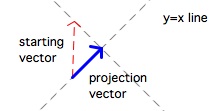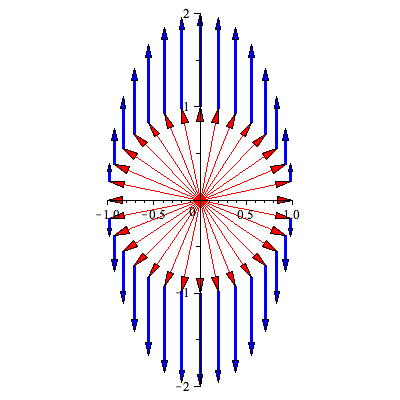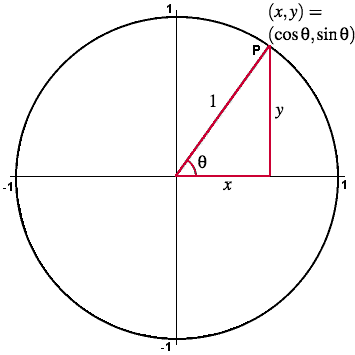A := Matrix([[21/40,3/20],[-3/16,39/40]]);
Execute the Eigenvectors(A); command
If ___ equals 0 then we die off along the line____ [corresponding to the eigenvector____], and otherwise we [choose one: die off or grow or hit and then stayed fixed] along the line____ [corresponding to the the eigenvector____].
 takes (x,y) to (1/2 x + 1/2 y, 1/2 x +1/2 y), ie projected onto the y=x
line. If we look at light rays perpendicular to the y=x line, this matrix
gives
us the shadow a vector makes onto the y=x line, which has
many applications in mathematics and physics. In other words, given
a starting vector,
we drop the perpendicular to the y=x line, and the base of the
right triangle we form is the projection vector.
takes (x,y) to (1/2 x + 1/2 y, 1/2 x +1/2 y), ie projected onto the y=x
line. If we look at light rays perpendicular to the y=x line, this matrix
gives
us the shadow a vector makes onto the y=x line, which has
many applications in mathematics and physics. In other words, given
a starting vector,
we drop the perpendicular to the y=x line, and the base of the
right triangle we form is the projection vector.

Execute with(LinearAlgebra): Enter M into Maple. Use commands like
M.Vector([-1, 1]);
to test M on different column vectors like (1,0), (0,1), (1,1), and (-1,1). Notice that any vectors on the lines y=x and y=-x, with basis representatives (1,1) and (-1,1), are eigenvectors for M. In addition, (-1,1) or anything else on the line y=-x gets sent to (0,0) which is still on the same line through the origin, so the eigenvalue is 0, and anything on y=x, like (1,1) gets fixed by M, so the eigenvalue is 1.]
A:=Matrix([[(cos(theta))^2,cos(theta)*sin(theta)],[cos(theta)*sin(theta),((sin(theta))^2)]]);
Notice that the eigenvalues are 0 and 1, just like in problem 5, so we can guess that this is a generalized projection matrix onto other lines.
theta=Pi/2 When theta is Pi/2, the line of projection is the y-axis

theta=Pi/2
What are the eigenvectors and eigenvalues in this case? You should be able to identify them from the picture.
Execute
theta := Pi/2
in Maple, and then execute
Eigenvectors(A);
and compare with the above picture. The eigenvalue of 1 corresponds to vectors on the line of projection, and the eigenvalue of 0 corresponds to vectors perpendicular to the line of projection.
The matrix A projects vectors onto the line through the origin that makes an angle of theta degrees with the positive x-axis [in number 1 above, the line was y=x, ie theta was 45 degrees from the positive x-axis. In this case sin and cos are sqrt(2)/2, so the matrix has all entries of 1/2 like M does].

Notice that theta is labeled in the picture above, and I have created a right triangle to the x-axis so that we can use the trigonometry of the unit circle. The hypotenuse is the line of projection for A. Why is the x-value of point P in the picture above cos(theta)? Why is the y-value sin(theta)? Use this to show that the slope of the hypotenuse from (0,0) to P=(cos(theta), sin(theta)) is tan(theta). Since the y-intercept occurs at (0,0), this would tell us that the line of projection is y=tan(theta) x.

Explain why the first column is an eigenvector corresponding to the eigenvalue of 1, and why the second column is an eigenvector corresponding to an eigenvector of 0. Hint: Where do the vectors lie in relation to the line of projection y=tan(theta) x. We found that the eigenvectors for the projection matrix A which projects onto a line of general angle theta was
P=

A:=Matrix([[(cos(theta))^2,cos(theta)*sin(theta)],[cos(theta)*sin(theta),((sin(theta))^2)]]);
Diag:=simplify(MatrixInverse(P).A.P)
What familiar geometric transformation is Diag?
If we want to project a vector onto the y=tan(theta) x line, first we can perform MatrixInverse(P) which takes a vector and rotates it counterclockwise by theta. Next we perform Diag, which projects onto the line _____________ . And finally we perform P, which rotates ___________________ by theta.